Writing… it can be quite the beast to teach! Especially when you have students who write only letter strings. How do you take Letter Strings to Sentences?! We asked our teacher colleagues from Fearless First Grade Teachers to offer their writing tips to get us started on this grand task. Now of course, these are not “waving a magic wand” tips that will transform your students’ writing in a day. All of these tips are in conjunction with daily modeling of writing a complete sentence.
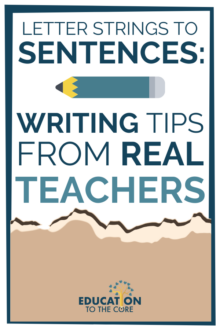
Writing Tip #1 ~ Hi-Light/Trace Sentences
“Model the apporiate sentence structure. Use highlights and have them trace.” ~ Melyssa D-T.
“Write the sentence for them and have them trace.” ~ Samantha B.
“Write it for them to trace. Then when i think they are ready, I have the kiddo tell me the sentence. I write it and then have the child copy it.” Barb T.
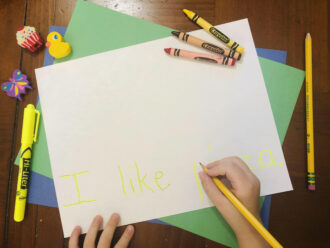
#2 ~ Boxes for Words
“Talk alot about the words the child speaks in the sentence he is writing. Then make the number of boxes to match the number of words. Help with inventive spelling. May take some modeling.” ~ Verity B-W.
“Draw boxes for each word. Explain that a word goes in each box. Model sounding out a word and form the sentence.” ~ Melissa C-L.
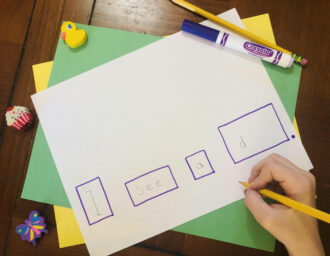
#3 ~ Draw Lines for Words
“Say the sentence, count the words, draw lines for each word. Have them (not you) say it word by word and have them write the sounds they hear. Have them reread the sentence as they write each new word. When they are done show them how it looks in a book by writing the correct word. In small group reading or phonics time depending on how they do stretching out sounds you may really need to work on their phonemic awareness. You also might look at, do they know the difference between a letter, a word, and a sentence.” ~ Brittani F.
“We count the number of words in the sentence the student wants to write. Then, I make lines and say each word as I do this. Then, we repeat the sentence while pointing at each individual line.” ~ Hope S.
“I also started making lines for my students. I’ve found it to be really effective and for some students I have them at least just write the sounds they hear in the word on the line. Then when we conference we go back together and work on spelling the words out.” ~ Aiyana M.
“Say the sentence several times. Count the words in the sentence. Draw a line for each word. Begin by just writing the beginning sound on the line.” ~ Jessica B.
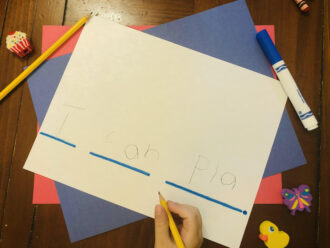
“Then slowly start having them write a word or two into sentence spots.. I draw a line for each sound in the word. Ex: __ brother played with __. They would add my (or often mi) to the beginning and me to the end. We work together to point and say the words before they are released to put in on their own.” ~ Maggie P.
“Have them count out the words in the sentence. So for “I went to the park” it would be 5 words. I draw a line for each of those words. And we work on writing it together. I used to do that in kindergarten and am currently doing it with one of my first graders. Seems to be working well.” ~ Jessica Y.
“Look up “writing continuum.” There are many out there. Writing is developmental and this is definitely a stage many children go through. Model how to listen to the beginning sounds of words, have the child write it, and then finish writing the word. Writing every day and modeling are huge for early writing.” ~ Jennifer B-H.
Writing Tip #4 ~ Cut-Up Sentences
“Does the child knows his letters and sounds ? Does the child know beginning and middle and end sounds? I will also asses if the child knows the difference between letters and words . I would do interactive writing And cut up sentences. Cut up sentences are powerful .” ~ Erika B.

Cut-Up Sentences can help students learn sentence structure. Add them to your small group centers.
“Scribe the sentence on a writing strip, then read it, and have the child read it. Cut it into word units and have the child build the sentence. Use the opportunity for grammar – starting with a Capital and ending with a full stop. Word attack skills and letter formation develop from this base at teachable moments (developmental readiness).” ~ Joanna G-M.
“I have found scrambled sight words sentences can help.” ~ Tracy A.
#5 ~ Start with Beginning Sounds
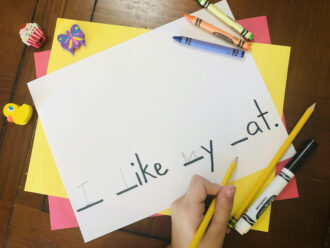
“Draw lines for each word. If they’re struggling to hear the sounds in the words, just start by having them write the first sound of each word. Then move to first and last sounds and eventually build up to middle sounds.” ~ Kelsey S.
“Clap and count words in a sentence, work on phonological awareness starting with beginning sounds, work on writing words in isolation.” ~ Lindsey P.
“Draw lines for the words on blank white paper and model beginning sound of each.” ~ Sara H-V.
#6 ~ Sticky Note Sentences
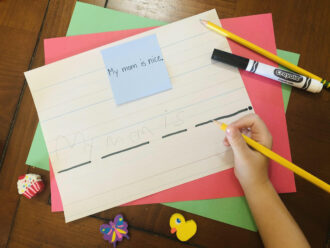
“I have them tell me the sentence and then write it on a sticky note and have them write it on their paper.” ~ Jeanette D.
“I have added a guided writing portion to my guided writing groups. One day a week I give them a dictated sentence and then they write a second sentence on their own.” ~ Kathy S-W.
“Have them repeat the sentence to you a few times before they work also. Then they write the letters they hear and I write the other letters. I have 2 like this and they do the picture first and then come to me.” ~ Jeannie S.
Writing Tip #7 ~ Labeling Pictures
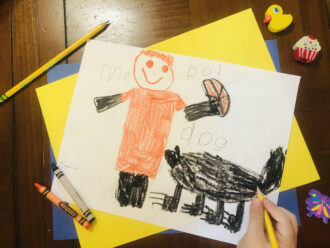
“Have them label the first sound in pictures to help guide them on to the next stage.” ~ Tara L.
“Model drawing and labeling a picture. Let them copy it. Then use the labels in simple sentences. Take suggestions for the sentence. Model stretching or tapping out words not in the picture. Count the words. Repeat the sentence out loud as many times as you can while writing it. Think aloud- “now I want to write the word apple. Oh that’s in my picture. I can spell it from there. A-p-p- “ etc.” ~ Yarina S.
#8 ~ Start with Sight Words
“Mine have a sight word folder, I have pages with about 24 boxes on a page, they write the new sight words each week in the boxes (copying from their book and the board). They could have this at home for virtuals. When we write I ask them to get out the sight word folder and spell those words correctly & they can sound out other words.” ~ Beth L.
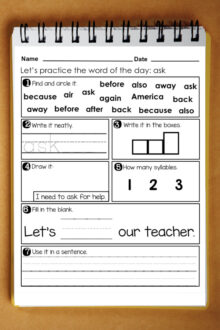
No Prep Sight Word Printables for Writing Practice
Writing Tip #9 ~ Elkonin Box Sentences
“In our small reading groups or during a writing conference, I would teach her how to stretch out words and write the sounds she hears. Towards the end of the year she began writing words and sentences. It was pretty amazing to see.” ~ Bethany J.
“I think it’s helpful to use elkonin boxes to understand and practice how to write words. Then, I’d move into counting out words in a sentence and drawing lines for each word.” ~ Kelly F.
“Magic lines and sound boxes. Make sure they have mastered their letter ID and sound rec.” ~ Dana E.
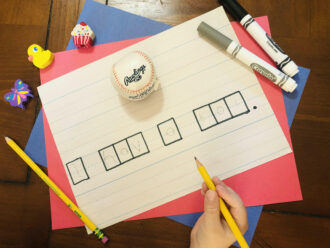
“Have him stretch out the words as he writes. Say each sound, and write what he hears. Maybe a talking tube, where he can hear himself say the sounds then write them?” ~ Lisa K.
“First, we start with tons of modeling full sentences, kids copying the full sentences. Then we talk about the mechanics or components. Second, we give lots of sentences with a missing word that kids copy and choose the missing word, like: My favorite leaf is _. (Red, yellow, smooth…). And we talk about and check mechanics. Last, we brainstorm ideas for a sentence, kids ask me to display words they need spelled. Then they write a sentence on their own. They check mechanics with a partner. These steps progress through an entire school year.” ~ Heidi N-C.
“Practice with dictated sentences. Say an entire sentence (not word by word)….He has a dog. Have the student count the words in the sentence as you say it. Then they need to draw a line for each word. This will help them understand each line represents a word. Repeat the sentence several times in full. Have the child repeat the sentence while pointing to each line. Now have them write the each word on the line. At first they may only write one letter for each word but that’s a start. Then you can model writing and stretching or tapping out each word as you write it on the line. As they get better at counting, drawing the lines and writing the first letter, you can move on to asking them, what other sounds do they hear in that word. It’s best to hold them accountable for remembering the sentence and the word they are trying to write (have them repeat the sentence if needed or you repeat the entire sentence – never word by word from you). Do this during small groups. ” ~ Tammie Y.
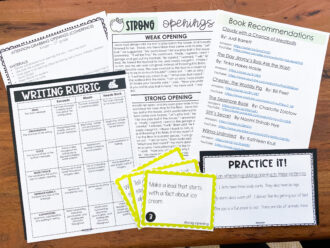
Once you’ve taught them how to write a complete sentence, you can take their writing to the next level. Using our Guided Writing Mini-Lessons, your students will begin to create great written works. Click on the link to check out all of the components included in this bundle!
“Writing, to me, is simply thinking through my fingers.” ~ Isaac Asimov
As a previous kindergarten teacher, almost ALL of my students came in writing letter strings, if they could write letters at all. But… by using many of these writing tips, I was able to take those Letter Strings to Sentences before the end of the school year. It may seem like a long road now, but with patient modeling and strategies in your toolbox, you will get there.
Written by: Janessa Fletcher
Thanks so much for stopping by! If you enjoyed this post, we’d love it if you could share Education to the Core with a friend and BOTH of you can receive $5 off a purchase of $10 or more with the code: FRIEND5.
At Education to the Core, we provide done-for-you curriculum that is simple, fun, and engaging! In order to be an effective educator, you have to take care of you first! We strive to make a healthy work-life balance a reality for you each and every day.
If you enjoyed this blog post, be sure to join my email list to get exclusive FREEBIES, exclusive content, updates, deals!




